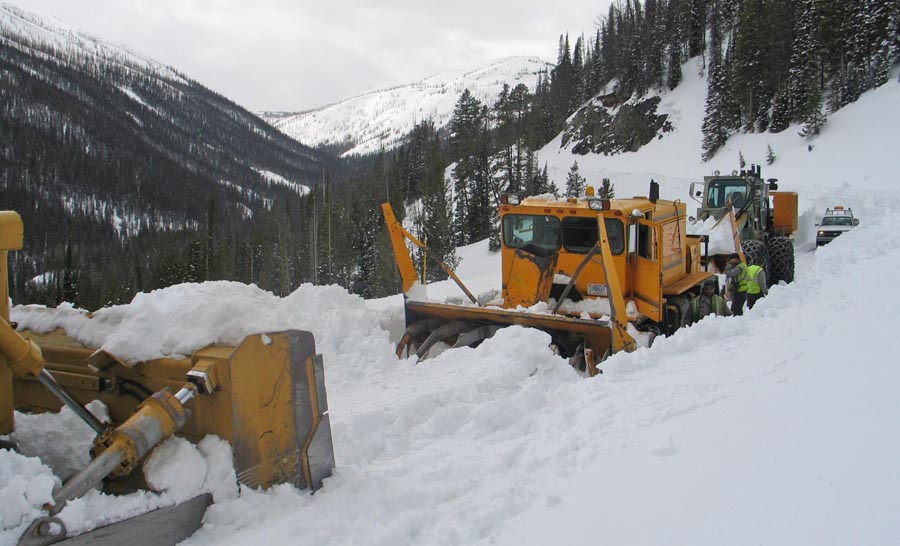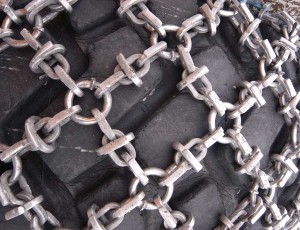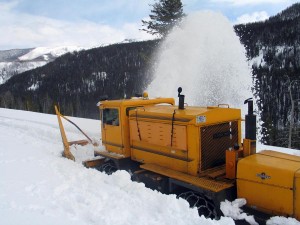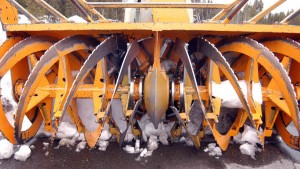
Two snow plows meet along the East Entrance road near Sylvan Pass in Yellowstone National Park during snow removal operations in spring 2011. (National Park Service photo - click to enlarge)
By Ruffin Prevost
Yellowstone National Park facilities manager Randy Baum was feeling pretty good a few weeks ago about how snow plowing was progressing along the park’s roads. That was before Mother Nature sent a potent spring storm through the area over Memorial Day weekend.
Roads over high mountain passes that had been plowed days earlier were suddenly covered with snow again, sending Yellowstone plow crews back to their rigs, and leaving some visitors wondering about the “start of summer” in the world’s first national park.
Plowing roads in wild weather alongside some drivers with little experience navigating snowy mountain passes can have it’s scary moments, Baum explained in April during an interview about the plowing operations he supervises each year.
“For some of these people, it’s their one and only time in Yellowstone. You’re trying to do road work, and there’s no way to detour the cars around, so you can have people coming at you from all angles,” Baum said. “The pressure can get to you.”
Each spring, Baum’s crew of 20-25 workers take to the snowy roads to start Yellowstone plowing work in the first full week of March to tackle one of the most complex, costly and expansive jobs in the park.

Heavy snow chains are wrapped around the tire on a rotary plow in Yellowstone National Park. (Ruffin Prevost/Yellowstone Gate - click to enlarge)
Road crews, including some seasonal workers hired just to help with Yellowstone plowing, work for up to three months removing snow and ice from more than 320 miles of road in Yellowstone. The operation burns as much as 1,300 gallons of diesel fuel each day and typically costs $1 million or more.
Most of Yellowstone plowing is done on roads that are above 6,500 feet in elevation, including Sylvan Pass at 8,525 feet, Dunraven Pass at 8,878 feet and 10,947-foot Beartooth Pass. Though it lies just outside of Yellowstone, Beartooth Pass is plowed by National Park Service crews each year.
Beartooth Pass didn’t open as planned over the weekend, and the other two passes — along with 8,262-foot Craig Pass on the Continental Divide between Old Faithful and West Thumb — were temporarily closed at least once over the holiday weekend, as a swirling mix of snow, sleet and rain moved through the area.
Motorists had mixed reactions to the closures, said Phyllis Sederberg at the Red Lodge, Mont. Chamber of Commerce, which posted updates online and fielded questions by phone from travelers about road conditions.
“Some people are totally shocked, but most anyone who is from around here just isn’t that surprised,” she said.
Yellowstone plowing no guarantee of clear roads
Not everyone takes road closures in stride, and some critics say that seasonally closed highways should be opened as soon as they can be cleared of snow, rather than on a fixed date that may come after the snow has melted. Others complain that it’s too difficult to get reliable information about openings and closures, especially in remote and isolated areas with no cell phone service.

Crews work in spring 2011 plow Sylvan Pass, the highest point along the east entrance road into Yellowstone National Park. (National Park Service photo - click to enlarge)
State and federal highway officials say they work hard to meet opening dates for roads and to keep them open, but that spring weather around Yellowstone typically means that travelers have to stay flexible and be prepared to find alternate routes.
A good attitude also goes a long way on a Yellowstone plow crew, Baum said.
Workers often spend long hours doing demanding work in tough conditions, all while staying in remote locations with few amenities.
And then there’s the prospect of steering a hulking rig with a massive set of rotating blades around a blind curve at 9,000 feet while pushing through 20 feet of drifting snow atop several inches of compressed ice.
“It’s not for everyone. It takes a certain breed,” he said. “You have to be a little crazy to do it.”
No crew member goes out to work alone, Baum said, and mechanics are sent out with each team. Having mechanics travel with plows is necessary not only because there’s often no easy way to tow one of the massive rigs back to a garage, but also because the Park Service uses equipment that has averaged up to 37 years old in recent years, Baum said.
In addition to a typical snowplow that most motorists might see using a fixed blade to push snow to the outside edge of a snowy highway, Baum’s crew uses rotary plows that chop through hard, frozen snow and ice and eject it to one side in a high arc.

National Park Service road crews use rotary plows to clear heavy snows at the end of the winter season in Yellowstone National Park. (Ruffin Prevost/Yellowstone Gate - click to enlarge)
The rotary plows used in Yellowstone are rated to move between 2,500 and 3,500 tons of snow per hour, Baum said. Newer machines used by some state highway departments are rated at 5,000 tons per hour or more, and can cost between $800,000 and $1.2 million.
While winter crews maintaining highways for auto travel will typically plow snow as it accumulates, the snow along Yellowstone’s interior roads isn’t plowed during the winter. Instead, it is packed down by groomers, snow coaches and snowmobiles all winter long. That means park roads often become white ribbons of compressed ice and snow that must be carved through foot by tedious foot.
“A lot of people ask why it’s so slow getting the roads open,” Baum said. “When the snow is that deep and you’re plowing, even at a full head of steam, you can walk faster than these rotaries travel.”
This year, at least until the holiday weekend, Yellowstone plow crews were ahead of schedule, thanks to a drier, warmer winter than last year. That was a welcome break for workers who are expected to stay on the job in all but the worst conditions.
“That group is out in all sorts of conditions. A blizzard doesn’t necessarily shut them down,” Baum said. “But they really enjoy it.”
“I liked it when I was still out there doing it,” said Baum, who worked for 20 years for the Montana Department of Transportation before moving to the Park Service 14 years ago. “I look forward to every day. It’s a challenge.”
Contact Ruffin Prevost at 307-213-9818 or ruffin@yellowstonegate.com.
